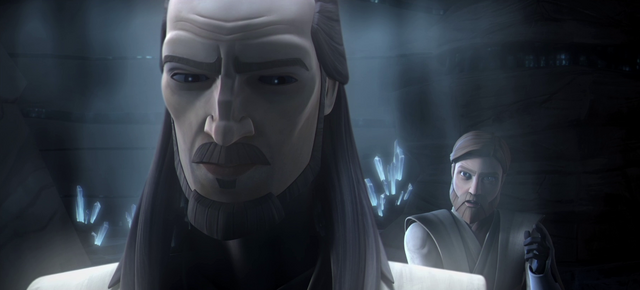
Probably the main reason my friend Pearlann, she of the numerous Expanded Universe Explains questions, never really got too into the EU herself was because she agreed with George Lucas on one key point: after Return of the Jedi, she felt, the story was over. She was never quite a movie purist; she’s read Dark Lord and Kenobi, for example, and even now is eagerly awaiting Heir to the Jedi—but she never had any problem with the notion that the Empire basically collapsed after Endor and all was right with the galaxy from then on.
While Lucas’s lack of involvement in EU plotting was a major factor for many, that’s probably as close as you could’ve come to an absolute dividing line between pro- and anti-EU fans back in the old days—whether one felt there was anything left to do with the characters after Jedi. In Mike Klimo’s Star Wars Ring Theory essay, which I’ve discussed previously, he details how the six films exist not just chronologically, but as a circle—how the two trilogies both parallel and mirror each other, and the extent to which Jedi even “links up” with The Phantom Menace to create a unified body of themes that begin in one place, evolve either positively or negatively, then return to where they began.
While the essay is very convincing, one can debate just how much of this detail was completely intentional on Lucas’s part—but what can’t be debated is that viewing the films through this lens as opposed to a strictly chronological one doesn’t really lend itself to the whole “expanded universe” thing. To a ring theorist, Star Wars is not unlike a clock; removing a piece would harm the entire structure, and adding extraneous bits and bobs would, too. What was Obi-Wan doing on Tatooine for nineteen years? How did Leia get her bounty hunter disguise? What happened in that nest of gundarks? None of that is relevant, and constructing explanations for them is superfluous at best, because that information isn’t in service to the clock. Read More



 The first issue of Marvel’s new Star Wars ongoing is in stores today, and it seems like the Marvel announcement was just yesterday. There’s a certain mistrust among the hardcore fans about this comic’s quality and it’s easy to see why: Dark Horse Comics were a class act, one that is going to be hard to follow, and modern Marvel are an unknown quantity for a big chunk of the fandom.
The first issue of Marvel’s new Star Wars ongoing is in stores today, and it seems like the Marvel announcement was just yesterday. There’s a certain mistrust among the hardcore fans about this comic’s quality and it’s easy to see why: Dark Horse Comics were a class act, one that is going to be hard to follow, and modern Marvel are an unknown quantity for a big chunk of the fandom.
